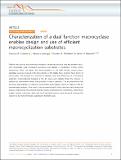Files in this item
Characterization of a dual function macrocyclase enables design and use of efficient macrocyclization substrates
Item metadata
| dc.contributor.author | Melo Czekster, Clarissa | |
| dc.contributor.author | Ludewig, Hannes | |
| dc.contributor.author | McMahon, Stephen A. | |
| dc.contributor.author | Naismith, James H. | |
| dc.date.accessioned | 2017-10-19T14:30:12Z | |
| dc.date.available | 2017-10-19T14:30:12Z | |
| dc.date.issued | 2017-10-19 | |
| dc.identifier | 250713833 | |
| dc.identifier | 37137a63-77d7-4ed2-b758-012fed9d1cd7 | |
| dc.identifier | 85031908533 | |
| dc.identifier | 000413197100005 | |
| dc.identifier.citation | Melo Czekster , C , Ludewig , H , McMahon , S A & Naismith , J H 2017 , ' Characterization of a dual function macrocyclase enables design and use of efficient macrocyclization substrates ' , Nature Communications , vol. 8 , 1045 . https://doi.org/10.1038/s41467-017-00862-4 | en |
| dc.identifier.issn | 2041-1723 | |
| dc.identifier.other | ORCID: /0000-0002-7163-4057/work/59222331 | |
| dc.identifier.uri | https://hdl.handle.net/10023/11887 | |
| dc.description | H.L. is funded by the George & Stella Lee Scholarship and Criticat EPSRC. This project was also funded by the European Research Council project 339367 NCB-TNT and by the BBSRC (K015508/1). JHN is 1000 talent scholar of the Chinese Academy of Sciences at the University of Sichuan. | en |
| dc.description.abstract | Peptide macrocycles are promising therapeutic molecules because they are protease resistant, structurally rigid, membrane permeable and capable of modulating protein-protein interactions. Here, we report the characterization of the dual function macrocyclase-peptidase enzyme involved in the biosynthesis of the highly toxic Amanitin toxin family of macrocycles. The enzyme first removes 10 residues from the N-terminus of a 35-residue substrate. Conformational trapping of the amino acid peptide forces the enzyme to release this intermediate rather than proceed to macrocyclization. The enzyme rebinds the 25 amino acid peptide in a different conformation and catalyzes macrocyclization of the N-terminal 8 residues. Structures of the enzyme bound to both substrates and biophysical analysis characterize the different binding modes rationalizing the mechanism. Using these insights simpler substrates with only five C-terminal residues were designed, allowing the enzyme to be more effectively exploited in biotechnology. | |
| dc.format.extent | 1765224 | |
| dc.language.iso | eng | |
| dc.relation.ispartof | Nature Communications | en |
| dc.subject | Enzyme mechanisms | en |
| dc.subject | X-ray crystallography | en |
| dc.subject | Biocatalysis | en |
| dc.subject | QD Chemistry | en |
| dc.subject | DAS | en |
| dc.subject | BDC | en |
| dc.subject | R2C | en |
| dc.subject.lcc | QD | en |
| dc.title | Characterization of a dual function macrocyclase enables design and use of efficient macrocyclization substrates | en |
| dc.type | Journal article | en |
| dc.contributor.sponsor | BBSRC | en |
| dc.contributor.sponsor | EPSRC | en |
| dc.contributor.sponsor | European Research Council | en |
| dc.contributor.institution | University of St Andrews. School of Chemistry | en |
| dc.contributor.institution | University of St Andrews. Biomedical Sciences Research Complex | en |
| dc.contributor.institution | University of St Andrews. EaSTCHEM | en |
| dc.identifier.doi | 10.1038/s41467-017-00862-4 | |
| dc.description.status | Peer reviewed | en |
| dc.identifier.grantnumber | BB/K015508/1 | en |
| dc.identifier.grantnumber | EP/L016419/1 | en |
| dc.identifier.grantnumber | NCB-TNT | en |
This item appears in the following Collection(s)
Items in the St Andrews Research Repository are protected by copyright, with all rights reserved, unless otherwise indicated.

